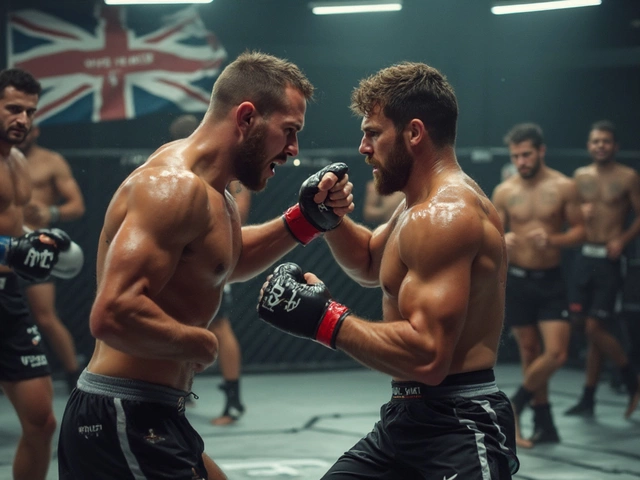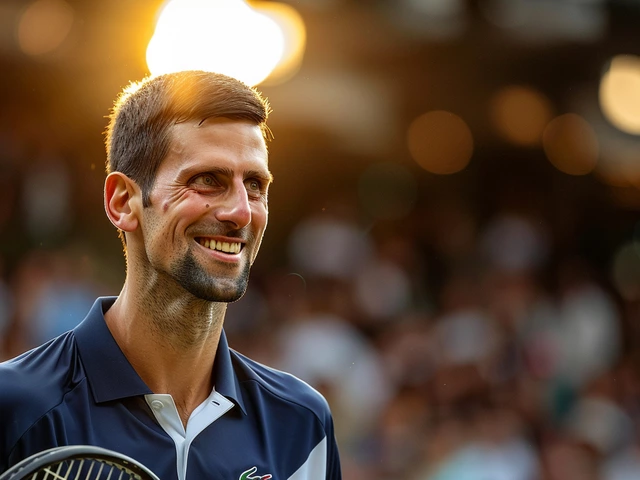Iconic knockouts in MMA and UFC stick with you—like the flash of Jorge Masvidal’s flying knee, or Conor McGregor’s left hand shutting the lights out in seconds. These moments reel fans back for every event, each of us hoping to witness the next viral finish. With new fights around the corner and fresh faces rising, the knockout chase never gets old.
If you’re thinking knockouts are all about raw power, you’re missing half the story. Split-second timing, reading your opponent’s game, and training muscle memory are what separate the legends from the highlight reels. Fighters like Anderson Silva and Amanda Nunes rewrote the playbook on how these spectacular finishes happen.
If you ever want to get into MMA or UFC—even just at the gym level—understanding what makes a knockout possible is gold. From striking basics and food choices to how fighters train reflexes, the inside knowledge can seriously up your own game or let you sound smarter than your buddies on fight night.
- Knockouts That Made History
- What Rules Set MMA and UFC Apart?
- Training Secrets and Fight-Ready Tips
- What Makes a Fan Favorite?
- Diet Plans and Fight Prep
- Recent Drama, News, and Odds
Knockouts That Made History
Some knockouts become legends overnight. You’ll hear people talk about them at barbecues, at the gym, and online for years. These moments shaped the story of the best knockouts in MMA and UFC and set the bar crazy high for fighters who came after.
Jorge Masvidal’s flying knee over Ben Askren still holds the record for the fastest KO in UFC history—just five seconds. Next on the highlight reel is Conor McGregor’s 13-second finish of Jose Aldo for the featherweight title, which made waves around the world, even showing up on sports channels that barely cover MMA.
- Anderson Silva vs. Vitor Belfort (2011): Silva’s front kick KO wasn’t just clean, it made every highlight show and inspired a generation of fighters to start practicing kicks their coaches swore never landed.
- Rashad Evans vs. Chuck Liddell (2008): Evans’ overhand right shocked everyone, especially since Liddell was considered one of the toughest chins in the sport back then.
- Gabriel Gonzaga vs. Mirko Cro Cop (2007): Nobody expected Cro Cop—famous for his own deadly kicks—to get knocked out by a head kick himself.
If you’re betting on fights, those one-punch or one-kick KOs turn the odds upside down. Sometimes, a massive underdog delivers the highlight that gets everyone talking; think Holly Holm’s head kick against Ronda Rousey in 2015. That moment snapped Rousey’s unbeaten streak and changed women’s MMA overnight.
| Fighter | Opponent | Event | KO Time (seconds) | Date |
|---|---|---|---|---|
| Jorge Masvidal | Ben Askren | UFC 239 | 5 | Jul 6, 2019 |
| Conor McGregor | Jose Aldo | UFC 194 | 13 | Dec 12, 2015 |
| Chan Sung Jung | Mark Hominick | UFC 140 | 7 | Dec 10, 2011 |
| Duane Ludwig | Jonathan Goulet | UFC Fight Night 3 | 6 | Jan 16, 2006 |
Knockouts don’t just draw fan attention; they’ve shaped the way fighters train and how fans talk about the sport. The best finishes blur the line between planned strikes and those “just go for it” moments that become part of MMA and UFC history.
What Rules Set MMA and UFC Apart?
You’ll hear people mix up 'MMA' and 'UFC,' but here’s the deal: MMA (Mixed Martial Arts) is the sport, and UFC (Ultimate Fighting Championship) is just the biggest promotion in that sport. Think of MMA like basketball, while UFC is the NBA. That helps explain why rules can shift depending on where fighters compete.
UFC follows what’s called the Unified Rules of Mixed Martial Arts. These rules are the standard in North America, but not every MMA show sticks to them. Here are some concrete differences:
- Best knockouts in MMA and UFC can look slightly different because some MMA promotions still allow things like soccer kicks or knees to the head on the ground. UFC bans those for fighter safety.
- Round structure might change. UFC goes with three five-minute rounds for normal fights, five rounds for title fights or main events. Some international MMA organizations still use one long ten-minute round followed by a shorter one.
- Glove style and cage/ring shape. UFC has its signature Octagon, but other MMA events might use a ring or a hexagon, which changes movement and fight tactics.
- Scoring systems are mostly 10-point-must, but local commissions in some countries use other ways to grade rounds, especially in Japan.
| Rule | UFC (Unified Rules) | Other MMA Promotions |
|---|---|---|
| Strikes to the back of the head | Illegal | Usually Illegal, but definitions vary |
| Knees to grounded opponent head | Illegal | Legal in some (e.g. ONE Championship) |
| Fight area | Octagon cage | Ring or other-shaped cage |
| Round length | 5 min rounds | Varies (some use 10 min first round) |
| Scoring system | 10-point-must | Varies by country |
If you’re keeping up with the latest news in MMA and UFC, always check where a card’s happening. Rules about eye pokes, grabbing the cage, or even how referees reset the action can shape the whole fight. Getting picky about these details is how the hardcore fans—and pros studying upcoming fights in MMA and UFC—get ahead, especially when looking at betting odds for MMA and UFC matchups.
Training Secrets and Fight-Ready Tips
If you’ve ever wondered how the big names pull off those wild finishes, the answer is never just luck. Clutch knockouts in best knockouts in MMA and UFC stuff usually come from months of planned training—and straight-up hard work. Fighters drill combos until they can throw them in their sleep. UFC champ Alexander Volkanovski literally records hundreds of rounds of sparring to fix mistakes fast. Amanda Nunes is known for her relentless focus on pad work and agility drills, which paid off with some of the most brutal one-punch KOs ever for a women’s champ.
Want to get fight-ready, or just train like your favorite fighter? Here’s what actually works:
- Footwork wins fights. Israel Adesanya credits his insane head movement and agility to shadowboxing drills and regular sprints. If you can’t move, you can’t land that knockout punch—or dodge one.
- Strength and recovery matter. Aljamain Sterling, the former bantamweight champ, was never the biggest power hitter, but his resistance workouts and long sessions on the rower gave him lasting energy in late rounds—perfect for capitalizing when a tired foe makes a mistake.
- React, don’t just attack. Leon Edwards shocked the world with his head-kick KO of Kamaru Usman. His coaches had him drilling that move for weeks, but also working on split-second reactions with ball-drills and mitt work.
- Diet is a weapon. Fighters like Dustin Poirier eat high-carb meals in the days leading up to weigh-ins, then switch to high-protein, low-fat foods just before fight night. This keeps their gas tank full and their muscles primed for knockout power.
- Mental prep is real. Big knockouts often come down to focus. Demetrious “Mighty Mouse” Johnson uses visualization and short meditation breaks in camp to stay sharp when it counts.
For anyone trying to start MMA, there’s no need to overthink it. Get a solid coach, follow a drip-feed of basic drills, and focus on one improvement at a time. Here’s a quick breakdown of what a typical fight camp week might look like for a pro who’s chasing that next viral KO:
| Day | Key Focus | Session Example |
|---|---|---|
| Monday | Striking Drills | Shadowboxing, pad work, heavy bag |
| Tuesday | Wrestling | Clinching, takedown entries, sprawling |
| Wednesday | Sparring | Light spar, focus on counters |
| Thursday | Strength & Conditioning | Lift, HIIT, sled pushes |
| Friday | Grappling | Jiu-jitsu flow, sub defense, scramble |
| Saturday | Active Recovery | Yoga, stretching, ice bath |
One last tip: record yourself. Even champions watch their own sparring or fights in slow-mo to spot habits or mistakes. Small tweaks can make the difference between missing a shot and landing one for the highlight reel.
What Makes a Fan Favorite?
Some fighters just grab everyone's attention, and it's not always about their win streak. Being a fan favorite in MMA and UFC comes down to a mix of personality, fighting style, and how they connect with people inside and outside the cage.
Let’s be clear: flashy finishes and best knockouts in MMA and UFC matter—a ton. Look at guys like Nate Diaz, who doesn't back down from anyone, or Khamzat Chimaev, who steamrolled through his first few opponents in a way you couldn’t ignore. Even if they’re not champions, fans stay glued to their fights because they bring excitement every time.
Crowd favorites usually check off a few boxes:
- They talk a big game, like Conor McGregor did—his press conferences are sometimes more talked about than the fights themselves.
- They finish fights. Folks love a clean KO or slick submission, especially when it looks one-sided for the other guy. Jorge Masvidal taking out Ben Askren in five seconds? That clip is everywhere, and it turned Masvidal from journeyman to star overnight.
- They stay active and take tough fights. Fans remember who steps up, like Justin Gaethje, who always puts entertainment first, or Donald "Cowboy" Cerrone, who never said no to a tough match-up.
- They interact with their supporters, whether that's signing autographs after a loss or chatting on social media between camps. People want to support fighters who come across as real, not just corporate faces.
Sometimes, being in the middle of recent scandals in MMA and UFC boosts a fighter’s following—like the way Jon Jones, for all his controversies, still draws massive crowds. Fans can’t look away, for better or worse.
When a fighter checks these boxes, it also influences betting odds for MMA and UFC. Oddsmakers know public favorites get tons of action, which can shift lines. Knowing who the fans love isn’t just fun trivia—if you’re placing a bet, it matters.
At the end of the day, being a fan favorite is about connection. People want to root for someone who’s electric, unpredictable, and maybe even a little polarizing. That spark is something you can’t fake.
Diet Plans and Fight Prep
Fight week is mayhem for MMA and UFC athletes. What they eat, when they eat, and how they train changes depending on weight class, the camp strategy, and the fighter’s style. Nailing the right diet isn’t just about dropping pounds—it’s about keeping speed, power, and stamina through intense rounds. Mess this up, and it doesn’t matter if you’re a beast in the gym. You’ll gas out when it counts.
Most UFC stars stick to a meal plan full of clean protein, fast-burning carbs, healthy fats, and loads of water—especially leading up to a fight. Think chicken breast, eggs, rice, oatmeal, avocados, sweet potatoes, and tons of spinach or kale. Meal timing is strict: some eat every couple of hours to keep blood sugar steady and stay fueled for workouts and cardio sessions.
| Fighter | Daily Calories (Fight Prep) | Main Protein Source | Weight Cut Water Intake |
|---|---|---|---|
| Kamaru Usman | 3,000-3,300 | Chicken, Fish | Up to 6 liters |
| Valentina Shevchenko | 2,200-2,600 | Eggs, Beef | 4-5 liters |
| Justin Gaethje | 2,500 | Lean Beef | 4+ liters |
Weight cutting is brutal. The last week can mean eating less, doing sweat sessions, and limiting sodium to shed up to 10% of total body weight. Some fighters start carb loading right after weigh-ins, munching on rice or white bread for fast fuel before stepping in the cage. But botch a cut—like we saw with some best knockouts in MMA and UFC, when fighters show up drained—and it’s lights out, literally.
Training before a fight is just as laser-focused as the diet. Heavy sparring ends about a week before, leaving room for pad work, light grappling, and explosive drills that keep mistakes to a minimum. Lots of fighters, like Israel Adesanya, swear by yoga or stretching routines in those final days for recovery and clarity.
- Eat balanced meals with lean proteins, complex carbs, and veggies.
- Don’t cut water too soon or too much—hydration is key even while shedding pounds.
- Pace workouts. Keep intensity high, but volume drops as you get closer to fight day.
- Stick to habits you trust—trying new stuff during fight week almost never works out.
Want to eat like a pro? Track every meal. Know your macros, and adjust weekly as you get closer to your goal weight. What fuels champions, fuels results—whether you’re cage-ready or not.
Recent Drama, News, and Odds
MMA and UFC headlines have been wild lately, with the sport’s biggest names making news both inside and outside the cage. The latest news in MMA and UFC always seems to blend knockouts, controversy, and last-minute fight announcements. Just last month, Jamahal Hill tested positive for a banned substance, sparking debates about stricter random drug testing—raising the topic for those worried about recent scandals in MMA and UFC. Meanwhile, the UFC 304 main card has been reshuffled on short notice, thanks to an injury to Leon Edwards. Dana White’s surprise announcement that Israel Adesanya will headline UFC 305 in Sydney got fans buzzing.
Bookies and fans are always scoping out betting odds for MMA and UFC events, especially when rematches or unexpected matchups happen. Current odds for UFC 305 put Adesanya as an early favorite at -175 against Dricus du Plessis—a sign that both hype and stats matter. If you’re into putting a little cash on the line, here’s a look at the latest odds for upcoming fights in MMA and UFC:
| Fight | Date | Favorite | Odds |
|---|---|---|---|
| Israel Adesanya vs. Dricus du Plessis | Aug 10, 2025 | Adesanya | -175 |
| Jon Jones vs. Tom Aspinall | Sep 14, 2025 | Jones | -190 |
| Alexa Grasso vs. Tatiana Suarez | Jul 20, 2025 | Grasso | -105 |
Drama isn’t just about fight results. There was a ton of fan backlash after the controversial split decision at UFC 303, with many arguing the judges “robbed” the underdog of a win. This kind of stuff feeds fan favorites in MMA and UFC—sometimes your popularity swings more from what happens after the fight than during it. It’s worth keeping an eye on social feeds: just last week, a viral video of Sean O’Malley’s bizarre weigh-in routine got as much traction as any KO highlight.
Some tips if you want to stay on top of the real action: follow up-to-date sources like MMA Junkie and the UFC’s official X account (formerly Twitter). Check the latest news in MMA and UFC before you place any bets, because injury pullouts and weight-missing issues are super common—nothing worse than betting based on a matchup that changes the night before.





